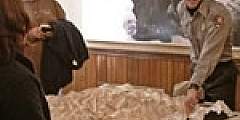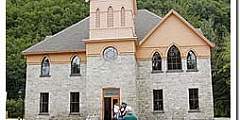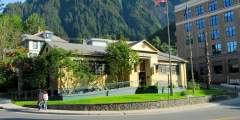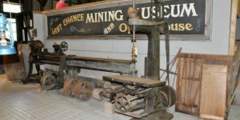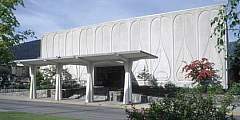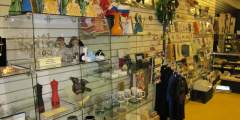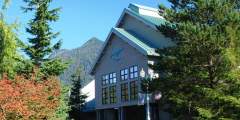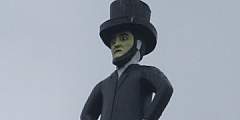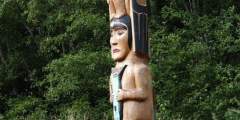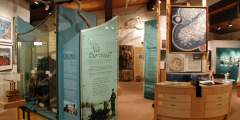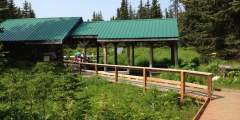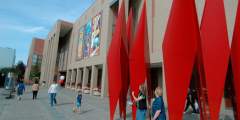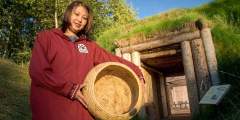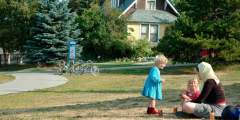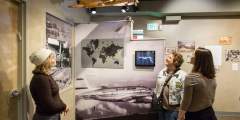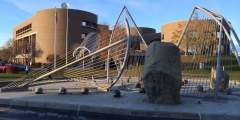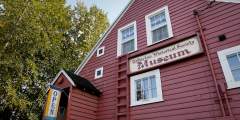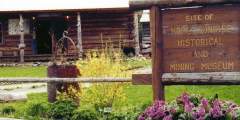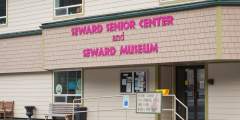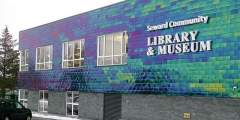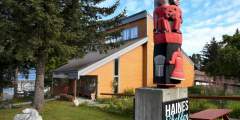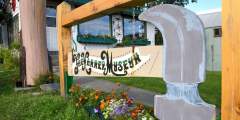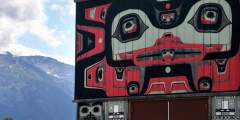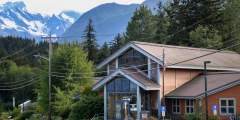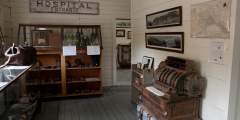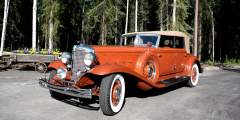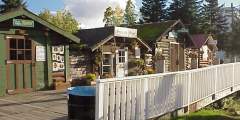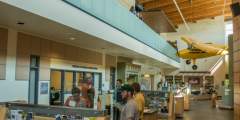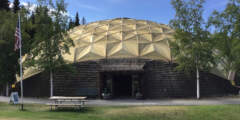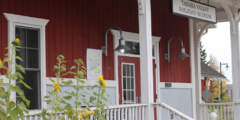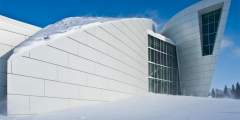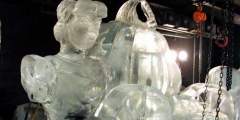Alaska Museums & Cultural Centers
Why Go
Alaska is made up of a fascinating—and wide—array of cultures, and its history is long and colorful. Walk into a museum and you can learn about ancient civilizations, the fervent gold rush of the late 1800s, or the pioneer spirit that built the state we know today. Plenty of Alaska's museums also illustrate Native cultures still thriving today, or the marine and animal life that make Alaska what it is. While some people may save museums for rainy days, walking through museums or cultural institutions is an excellent way to gain a deeper appreciation for Alaska's entire landscape.
Price Range
Admissions range from free to $25, with discounts common for kids, seniors and military.
Best Time to Go
Year-round, though many museums and heritage centers have more limited hours during the winter.
Where to Go
Here are the most notable museums in Alaska, from popular destinations like Anchorage, Juneau, and Fairbanks, to those found off the beaten path.
Show Map
Museums & Cultural Centers
Skagway View All
This gold rush town is almost a museum in itself—with 23 blocks of 19th-century buildings preserved to tell the story of the crazed pursuit of gold more than a century ago.
Housed in the circa 1898 White Pass & Yukon Route Railroad Depot, the historic Moore house and the Mascot Saloon. Collections consist of over 200,000 archaeology artifacts associated with the Klondike gold rush and 3,000 copies of historic photographs of the gold rush period. Library and 100-seat auditorium. Guided tours, interpretive programs, films and permanent exhibitions. Hours May-Sep: Daily 8am-6pm Admission No admission fee,… ...more
A good place to start any tour of Skagway is the former White Pass and Yukon Railroad Depot. This massive, colorful structure, built in 1898, was a dominant part of Skagway life until 1969, when railroad operations moved to the WP&YR’s new building two doors east. The old depot is now the National Park Service Visitor Center, where visitors can enjoy movies, walking tours and other activities during the summer. Although the tracks are now… ...more
Skagway’s unique history as a vital transportation corridor and gateway to interior Alaska and the Yukon is portrayed in the artifacts, photographs and historical records of the past century. The Museum is located in the town’s magnificent City Hall, this is the first stone building in Alaska, built with granite from Canada that was transported on the WP&YR Railroad. On display are items such as a Tlingit canoe, a Portland Cutter sleigh,… ...more
Nome View All
This remote town is the ideal launching pad for exploring the villages of the Bering Straits. It's also where you'll find Alaska’s best native ivory carvings, baskets and skin sewing. The Carrie McLain Memorial Museum is Nome's only museum, which details the remote town’s gold rush days, the arrival of Wyatt Earp and its sled dog heritage.
Discover gold nuggets from Nome’s rich history at the Carrie M. McLain Memorial Museum, open Tuesday – Saturday in the Richard Foster Building. Interactive exhibits feature the natural landscape, Alaska Native artwork, and the town of Nome from its Tent City beginnings to its present-day role as a regional hub.
Go back to Beringia, way back, to a time when woolly mammoths and scimitar cats roamed the land. To a time when a 1,000-mile-wide migration corridor linked Alaska and Russia. (That’s how indigenous people got to North America.) Learn all about it at the Bering Land Bridge National Preserve Visitor Center.
Opening in October 2016! Kawerak Katirvik Cultural Center is a meeting place for sharing, celebrating and understanding the cultural traditions and language of the Central Yup’ik, St. Lawrence Island Yupik and Inupiaq peoples of the area. Call ahead for events, which can include Elder stories and dancing. Or stop by to check out the interactive educational displays.
Eagle
The Eagle Historical Society is made up of six restored buildings from the late 19th century, which allow you to walk back in time to the gold rush and pioneering days here.
Exhibits in six restored historic buildings dating from the end of the 19th century: James Wickersham’s first Courthouse, U.S. Custom House, the Improved Order of Red Men Lodge and three Fort Egbert buildings, all with period furnishings. Displays with photographs on the Gold Rush town, military fort and commercial center with judicial, communication, transportation, construction, agriculture, mining, pioneer activities and social… ...more
Juneau View All
The state capital is home to the Alaska State Museum—a huge collection of Native artifacts, as well as Russia-American memorabilia—and the Juneau-Douglas City Museum, which chronicles the city's gold-panning past.
This museum sits on the site where Alaska officially became a state. View the exhibits and watch an award-winning documentary about the city. Plus, the City Museum doesn’t end at the building’s walls. From May to September, you can take walking tours of historic downtown Juneau and the Alaska State Capitol.
Hours Friday: 11am-5pm Saturday: noon-4pm or by appointment Admission Free
Located in the historic compressor building associated with the former Alaska Juneau Gold Mining Company which operated in Juneau from 1912 until 1944. The museum features one of the world’s largest air compressors and other industrial artifacts associated with hard rock gold mining. The site also includes electric locomotives and rail cars which hauled men to the mine and ore to the mill. Access to the museum is via a short hike up the hill… ...more
Newly renovated in 2016. Established in 1900, the Museum collects, exhibits, and interprets the human and natural history of Alaska. The Museum features a full-size bald eagle nesting tree and extensive ethnographic exhibits on the cultures of Alaska’s Native people. Two galleries offer changing exhibits.
Utqiagvik (Barrow)
You'll find a living museum of sorts in this extreme village, the northernmost town in the U.S., but don't miss the Inupiat Heritage Center, which covers both traditional crafts done here as well as the commercial whaling industry.
Houses exhibits, artifact collections, library, gift shop, and a traditional room where people can demonstrate and teach traditional crafts in Elders-in-Residence and Artists-in-Residence programs. As an affliated National Park, the North Slope Borough owns and manages the Inupiat Heritage Center.
Sitka View All
Once the headquarters for the Russian settlement here in the 1800s, this Southeastern town offers, through museums and its iconic church, the chance to step back into a very different Alaska. Sitka's also home to the Sheldon Jackson Museum, one of the best collections of Native arts and crafts you'll see anywhere.
Dr. Sheldon Jackson, museum founder, had the distinction of serving in three pioneer fields during the late 1800s, founding Protestant missions and schools, establishing the public school system, and introducing domestic reindeer. In his travels he reached many sections of Alaska, as well as the coast of Siberia, gathering the majority of the artifacts now seen in the museum. Located on the campus of Sheldon Jackson College, the museum was… ...more
Walking the streets of Sitka, you may find it hard to believe that this quiet coastal community was once the hub of the West Coast: a center for trade, diplomacy, and the arts. When San Francisco had less than 10 residents, Sitka was home to 800 Russians, Europeans, Tlingits, and Aleuts. The oldest town on the West Coast, it was the capital of Russian America — called New Archangel — and was booming from the early 1800s through the United States’… ...more
This is a fun little treasure hunt for kids. The money tree isn’t marked, but it’s near the start of the Totem Trail. Look for a tree stump, about a foot and half tall, that’s filled with coins. Where the branches have broken off, there are coins in the little holes. People have been putting coins in this tree for over 50 years; if you can find the tree, join the tradition!
Explore a large, scale model of Sitka from 1867, the year the Russians transferred the Territory to the United States. View exhibits on traditional Tlingit lifestyles and see a collection of tightly woven cedar and spruce root baskets. Or learn about the town blackouts and a large-scale military buildup in Sitka during World War II. The museum is the only place in Sitka that includes all three elements of the town’s history – Tlingit, Russian… ...more
Ketchikan View All
This small town in the Southeast has, in a handful of parks— the Totem Heritage Center, the Saxman Totem Park and the Totem Bight Park—more totem poles than anywhere in the world. You’ll see both century-old relics, as well as poles being carved by emerging artists today.
Experience world-class exhibits and audiovisual programs. Discover Tsimshian, Haida and Tlingit totem poles, the rainforest room, a Native fish camp scene, and exhibits on Southeast Alaska’s ecosystems, fishing, mining, timber and tourism. Located one block from the cruise ship dock in downtown Ketchikan. Accepts America-the-Beautiful passes.
The art of totem pole carving was a luxury that experienced its heyday in the mid-1700s to the late 1800s. The fur trade had provided the Tlingit, Haida and Tsimshian peoples a newfound sense of wealth – and time to focus on the artistry of the totem
As part of the New Deal during the 1930s, the Civilian Conservation Corps came to this area and hired skilled Native artists who could recreate old crumbling poles and train apprentices, to keep the art form alive. You can wander the grounds at this state park, and learn about how to interpret the symbols on poles, or check out the large, carved tribal house. Was named to the National Register of Historic Places in 1970. 10 miles out of town on ...more
Built on the old fishing grounds of Tlingit Natives, the park hosts some of the finest native art in the world!
In the museum are artifacts,text and photos telling of Alaska’s spirited First City as a Native fish camp, mining hub, salmon canning capital, fishing port and timber town. The Centennial Building commemorates the purchase of Alaska from Russia in 1867. In front is the Raven Stealing the Sun pole, carved by Dempsey Bob and raised in 1983.
If you want a chance to sit back and enjoy an iconic view of Alaska, catch up on your work, or peruse a large collection of Alaskana, there’s no more perfect place than the new Ketchikan library.
Listed on the National Register of Historic Places, this collection of 19th century totem poles is the biggest in the world. Salvaged from abandoned Haida and Tlingit villages, some are as old as 160 years — no small feat, since totem poles usually deteriorate in less than a century. You can take a quick, free tour, or check out the current exhibits of contemporary Tlingit art.
Homer View All
This artists-and-anglers town has an excellent repository at The Pratt Museum, a look at the art, culture and science in Kachemak Bay, while the Alaska Islands and Ocean Visitor Center is a 60-acre marine wildlife center with great nature trails.
Homer’s Pratt Museum preserves the stories of the Kachemak Bay region and provides a gathering place for people to learn and to be inspired by this region and its place in the world. The museum’s extensive collection offers an excellent way to learn more about the landscape, communities and ecosystems of the area.
While you’re exploring Homer and it’s ecological-rich environs, a stop at the Center for Alaskan Coastal Studies adds to your appreciation of the history and wildlife of the area.
Anchorage View All
Many visitors start their Alaskan trips here, and there’s no better way to get a grasp of Alaska's stories through places such as the Anchorage Museum at Rasmuson Center —a comprehensive looks at Native and state history, accented with a lot of art—the Alaska Native Heritage Center, the Alaska Aviation Museum or, if you're with kids, the hands-on science museum the Imaginarium.
There’s no better place to get a grasp on Alaska’s history — really, its many histories— than by visiting the Anchorage Museum. The state’s largest museum is truly a world-class experience, offering a compelling overview of Alaska history, art, culture, and science.
This Anchorage Cultural Center offers an in-depth look at Alaskan Native life — with a big focus on Alaska Natives. Watch dancing, listen to stories, meet carvers, and hear from artists. The setting is so small and intimate that visitors are sometimes even invited to join the dancers on stage.
What was it like for a family living in Anchorage in 1915? The Oscar Anderson House Museum, located in Elderberry Park at 5th Avenue and M Street, is the perfect way to find out.
Homesteaders. Entrepreneurs. Photographers. This petite, but very well-done museum in midtown Anchorage offers engaging proof of how the state of Alaska has been shaped — and is still being shaped — by a diverse community. It’s open 1pm — 6pm Sunday through Thursday year-round (closed Friday and Saturday for the Jewish Sabbath). It takes only 15 minutes to see the exhibits, but you can also watch a 90-minute video about Warren Metzker, a legend ...more
This Anchorage library is much more than a spot for locals to check out books — it’s one of the most spectacular buildings in Anchorage and a true destination for visitors. With a large section of Alaskana, gorgeous artwork, and numerous events, it’s a great place for travelers to get a better sense of the state. Free wi-fi, public computers, and laptops for rent offer are other resources you can find here.
Talkeetna View All
The Talkeetna Historical Society looks at the town’s history of mining, flying and the railroad. The centerpiece: a 12-foot-by-12-foot display of Mt McKinley.
Learn about this rural town’s native, gold mining, and aviation history in this museum housed in a little red school house, as well as a number of smaller, old railroad buildings. You’ll find out about ice roads and horses wearing snow shoes, how airplanes took over from tractors, as well as information about bear traps, native artifacts, and how folks survived the harsh winters of the Susitna Valley. Also, see some of the original trappers’… ...more
Hope View All
The Hope-Sunrise Historical and Mining Museum houses photos and artifacts from the Turnagain Arm gold rush in 1896—complete with a mine bunkhouse, rock crushers and dog sleds.
The Hope-Sunrise Historical and Mining Museum exhibits photographs and artifacts of the Turnagain Arm Gold Rush of 1896 and the years since.
Seward & Kenai Fjords View All
The Alaska SeaLife Center is a huge, interactive look at marine life and marine research, while The Seward Museum recounts the town’s history using photos, artifacts and documents, housing an impressive collection of Native baskets and ivory carvings.
The museum presents the chief events of Seward’s history through photographs, artifacts and documents. There is also a fine collection of Native baskets and ivory carvings on display. During the summer there are evening programs consisting of two slide shows: The History of Seward and The History of the Iditarod Trail. A special open house is held every August 28 in honor of the founding of Seward in 1903. Museum shop carries books by local ...more
The local history museum, operated in partnership with the Resurrection Bay Historical Society, is situated on the first floor. The library, located on the second floor, offers computer with internet access, youth programs, and preschool story time for no cost.
Haines View All
The Bald Eagle Foundation pays tribute the iconic creatures that flock to this small town, through displays, dioramas and videos, while the Hammer Museum is dedicated to—yes—hammers, with 1,500 on display.
Discover Haines! The Sheldon Museum is the museum of the Chilkat Valley. Experience the art and culture of the Tlingit people. Re-live pioneer days, explore the gold rush, the Dalton Trail and life at Fort William H. Seward. The museum store has a large selection of local and Alaskan books and art. Accredited by the American Association of Museums. Hours Summer Mon-Fri: 10am-5pm Sat-Sun: 1pm-4pm Extended… ...more
A collection of approximately 1400 types of hammers, representing many different trades and uses, housed in a cottage-style house. The Hammer Museum provides a journey into the past through the use of man’s first tool. From ancient times to the present, the hammer tells the story of man’s progress and ingenuity. A unique adventure for the whole family.
The dream of the famed Chilkat tribe of Tlingit Indians, this working museum honors the great legacy of Northwest Coast art as practiced by a proud and wealthy people. It houses the famed Whale House artifacts while serving as a workshop for contemporary carvers and weavers.
The American Bald Eagle Foundation and Live Raptor Center is a non-profit education center located near the post office, a few blocks from downtown Haines. And in the summer, the center hosts live raptor programs featuring bald eagles, owls, hawks, and other birds of prey. The museum has an enormous room filled with realistic taxidermy displays of a wide variety of Alaskan critters. You’ll also find a variety of habitats and species ...more
Built like a cathedral but with two stories of windows to let the outdoors in, the Haines Library is a gathering spot for visitors and residents alike. Three easy chairs at the end of its great hall are a privileged nook for patrons who get there first. When opened in 2002, Library Journal ranked this as the nation’s finest small library. Find a book or magazine, sink into the rocking chair or an easy chair and soak in the view. You’ll feel like ...more
McCarthy-Kennicott View All
The ghost town of Kennicott has been taken over by the National Park Service, and you can explore this site that has become a museum unto itself.
You can’t escape the town’s historical dynamic, and this museum is the best place to get the inside scoop on its past, including the copper rush that happened between 1900 and 1938. The museum building itself is a piece of history, having once been the railw¬ay depot. Check out the pictures of railway construction — 196 miles of track from Cordova — which are alone worth the visit. You’ll also find photos and artifacts that give you an idea what… ...more
Fairbanks View All
This northern city has an interesting mix, from the Museum of the North—once voted the best in Alaska—to the Supercomputing Center, where you can learn about predicting tsunamis. Fairbanks is also a popular launching pad for visiting Arctic villages, where you can experience the culture firsthand.
Alaska’s road to modernization a century ago was a dramatic journey, and the Fountainhead Antique Auto Museum explores that journey in fun, vivid detail. On the grounds of Wedgewood Resort — a member of the city’s premier, locally owned hotel group — the museum showcases dozens of historically significant pre-World War II automobiles, and offers visitors a trip back to Alaska’s rugged and exciting formative years.
Experience the interior of Alaska 100 years ago! Pioneer Park is a historic village that features original buildings moved from downtown Fairbanks, as well as museums, and the Gold Rush. Come enjoy the carousel and train that runs the perimeter of the park, an array of local shops, and rustic cabin restaurants. Stay for a couple of hours or spend a full day; Pioneer Park offers fun for the whole family.
The Morris Thompson Cultural and Visitors Center in downtown Fairbanks has brochures, maps, free WiFi and telephone, daily lodging availability, and local walking and driving tours. Serving as the regional visitor facility, the friendly and knowledgeable staff have answers to all your questions.
The mission of the Pioneer Air Museum is to collect, protect, and preserve for educational purposes objects that reflect the history of interior and arctic Alaskan aviation through acquiring, restoring, interpreting, and displaying historically significant objects. View logbooks, clothing, maps, early flight instruments, and aircraft sporting skis and floats adapted to rugged Alaskan runways.
Visitors can purchase tickets to hop aboard the Crooked Creek Whiskey Island Railroad encircling Pioneer Park and pulled by Old 67. It’s just $3 for adults and $2 for seniors and kids under 12 (lap babies are free). The train runs every 15 minutes during the open season from noon to 7:30pm. An on-board guide points out historic attractions and activities in each section.
From Alaska native art to polar dinosaurs, you’ll find something interesting on exhibit here. Head to the centerpiece of this museum, the Rose Berry Alaska Art Gallery, to see the full spectrum of Alaskan art, from ancient Eskimo ivory carvings to contemporary paintings and sculptures.
Devoted to all things ice, this museum will put you in a winter mood no matter what the summer temperatures are like. You’ll see several large ice displays, a freezer you can go in to feel like it’s 20 degrees below zero, a huge-screen slide show with the annual World Ice Art championships, and freezers with huge ice tableaux.


